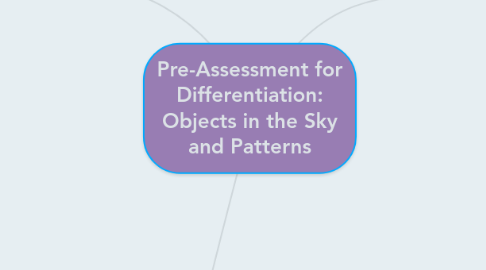
1. 5 students who appear to have limited Knowledge about the topic
1.1. Four Corners (Assessment)
1.1.1. Students will be able to answer questions about our topic
1.1.2. Students will pick one corner with an answer on it
1.1.3. Students will be able to defend their answers and will get a chance to change or stay in their spot.
1.2. Strategy 1
1.2.1. One-on-one instructions
1.2.1.1. I will teach students vocabulary terms to use in the Frayer Model
1.2.2. Small group activities and instructions
1.2.2.1. Students will use a Frayer Model to define and illustrate the sun and the moon.
1.3. Strategy 2
1.3.1. Technology use
1.3.1.1. Students will work in pairs to create videos to describe their observations and learnings
2. 5 students who answered most, including the most difficult, of the pre-assessment questions correctly
2.1. Observation and Questioning (Assessment)
2.1.1. Ask students open-ended questions
2.1.2. Ask challenging and critical thinking questions
2.2. Class Presentations (Assessment)
2.2.1. Provide students with a rubric to follow
2.2.2. Students will share their findings with their class by using a technology tool (I will provide assistance with the technology part if needed)
2.3. Strategy 1
2.3.1. Interest Inventory and Independent study
2.3.1.1. Students will pick a topic to use for detailed research
2.3.1.2. Students will create a model using Oreo cookies for each phase of the moon
2.3.1.3. Students will use a journal to track the time between the moon's phases
2.4. Strategy 2
2.4.1. Use Bloom's Taxonomy multiple skill levels to allow students to select a Visual-Saptial tasks and describe its movement
3. 12 students who have some knowledge about the topic as shown in their score, but need to develop higher order thinking skills
3.1. Online Concept Map (Assessment)
3.1.1. Students will share their understanding of the moon phases by drawing and describing each phase on an online concept map
3.1.2. Students will use vocabulary words provided by me
3.1.3. Students will be able to describe each phase and how it occurs
3.2. Filed Trip (Assessment)
3.2.1. Students will visit Phoenix Science Center
3.2.2. Students will write reports to describe one/tow things they learned from the visit
3.2.3. Prior to the visit, I will ask each student to prepare a "Curiosity question" to ask for the museum's guide
3.3. Strategy 1
3.3.1. Flexible Grouping
3.3.1.1. Ask an open-ended question: Why does the moon have different phases?
3.3.1.2. Students work together to gather information and answer the question by using books and online resources
3.3.1.3. Each member will have a specific role in his/her group (presenter, artists, speaker...)
3.4. Strategy 2
3.4.1. Learning Centers
3.4.1.1. Hands-on activities to allow students to understand the concept
3.4.1.2. Comparison chart to use (Students will have a chance to pick two objects to compare)
